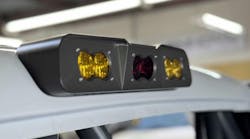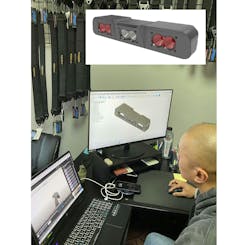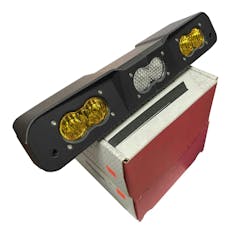Off-Road Excellence: A Case Study of Precision Machining and Craftsmanship
In the heart of SoCal’s off-road haven, the Kibbetech workshop hums with the sounds of machinery, rock music and a group of skilled craftsmen doing what they do best—designing and fabricating custom truck builds and production parts.
Since its founding in 2006, Kibbetech has been challenging industry norms and setting new standards of excellence. The seeds of owner Ryan Kibbe’s journey were sewn when he was dissatisfied with the practices of an off-road shop he previously worked for and decided to carve his own path.
Setting up his beginnings under an E-Z Up canopy in the side yard at his father’s end-unit sheet metal shop, Kibbe brought his vision to life. During the next 18 years, the shop—with its small and respected crew—has forged a name for itself in the industry. “One thing I hold close is our design and manufacturing,” he told Machine Design. “With everyone outsourcing designs and [production], I keep everything under my roof right here, creating jobs and adding value to our products.”
During a recent visit to the shop’s Newbury Park location, Kevin Strom, CNC programmer/process engineer, showed Machine Design what Kibbetech has been up to lately. The company’s mission is two-fold: One side of the business is custom fabrication and the other is product development and production. They offer a range of services—including design and hand fabrication such as sawing, grinding and welding—but the precision machining, laser cutting and forming is what gives the shop its edge.
The Role of Innovation
In the past 5-10 years there has been a significant shift toward utilizing advanced technologies such as computer numerical control (CNC) in the manufacturing process, Strom said. And Kibbetech is one of the fewer small shops to provide this service. While top podium race truck builders (think Mason Motorsports) have long been embracing CNC technology, its broader adoption in the market has been limited.
The goal for many companies is to move away from traditional hand-fabricated methods toward computer-aided design (CAD) and manufacturing (CAM). This transition offers cost-effectiveness, higher quality and increased consistency in producing parts, Strom said, because each piece built adheres to the same quality of standards—independent of who worked on it—ensuring a standard level of excellence across all products.
Kibbetech uses Autodesk Fusion, an integrated CAD/CAM software, along with sophisticated machining equipment—including a 5-axis HAAS UMC-1000, 3-axis HAAS VF-4 and a HAAS ST-20 lathe—to achieve its high-end results.
While off-roading and race trucks dominate the West Coast market, there is also a demand for specialized builds like drift trucks; one of Kibbetech’s most popular parts is its hydraulic brake handle.
Apart from custom fabrication, the company focuses on product development within the industry, offering aftermarket parts for popular truck models. While touring the machine shop, upper suspension control arms were being machined on the 5-axis machine, and a host of spindles and other parts were waiting in line for anodizing.
When asked about part design, Strom said the proper design of parts has all come from the vast experience of the owner. “Ryan has been in the industry essentially his whole life, and the ideas literally come from his brain. He then directs us how to design the part. There are critical dimensions that must be hit for the part to be a good part,” Strom said.
READ MORE: CAD/CAM Roundup: Engineering Software Productivity Tools and Services
Advantages of Rapid Prototyping
Collaboration within the team is critical for translating design concepts into manufacturable components. Technologies like 3D scanning, CAD and additive manufacturing play a vital role in this process, allowing them to iterate on designs and address potential manufacturing challenges effectively, Strom said.
When faced with the challenge of crafting a custom third brake light for a bespoke luxury prerunner truck build, the workshop’s design engineer, Phonexay Douangmala, said, “We pulled out all the toys for this project,” leveraging the synergies of CAD design, 3D scanning and 3D printing. Strom printed the prototype on a Bambu Labs X1C 3D printer, creating a part that is paving the way for a new era of customization.
While Strom was demonstrating the Autodesk Fusion software on his desktop, a co-worker had been checking the fit of the brake light prototype. He peeked his head around the corner and told Strom: “That brake light fits perfectly.” From there, the part was machined on the 5-axis HAAS, anodized and assembled, and now resides on the prerunner. And Kibbetech is in the process of machining more to meet a new product demand.
READ MORE: Autodesk Fusion App Improves Design Process
Driving Forward: Kibbetech’s Vision for the Future
Kibbetech’s use of precision machining techniques, advanced technologies and the integration of CAD/CAM software represents a progressive shift in manufacturing methodologies. The shop’s reliance on automated processes ensures quality control and a uniformity of output that sets a high industry standard. Merging their expertise with the right tools, the shop has refined the art of customization to a precise level, achieving industry success.
So, what’s the secret? “Success is always a funny word for me,” Kibbe answered. “I still feel like I have a long way to go no matter where I or the company is at. I guess that is what keeps me pushing for more.”
When asked what’s next, Kibbe had this to say: “My goal is ever-changing. I would like to streamline our production parts and our custom truck builds so we can deliver a better product more efficiently. Also, it is my dream to have an in-house race truck so I can go racing and take all my guys out to the races to really enjoy the fruits of our labor!”




